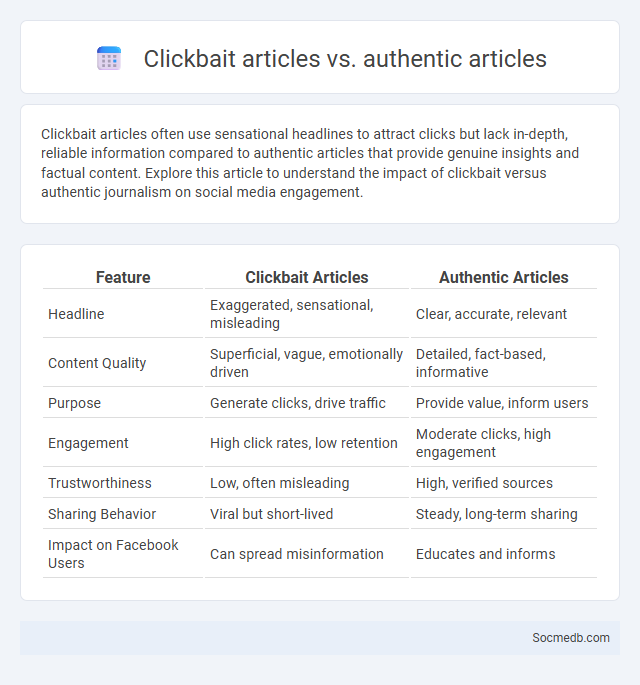
Photo illustration: Clickbait articles vs authentic articles
Clickbait articles often use sensational headlines to attract clicks but lack in-depth, reliable information compared to authentic articles that provide genuine insights and factual content. Explore this article to understand the impact of clickbait versus authentic journalism on social media engagement.
Table of Comparison
| Feature | Clickbait Articles | Authentic Articles |
|---|---|---|
| Headline | Exaggerated, sensational, misleading | Clear, accurate, relevant |
| Content Quality | Superficial, vague, emotionally driven | Detailed, fact-based, informative |
| Purpose | Generate clicks, drive traffic | Provide value, inform users |
| Engagement | High click rates, low retention | Moderate clicks, high engagement |
| Trustworthiness | Low, often misleading | High, verified sources |
| Sharing Behavior | Viral but short-lived | Steady, long-term sharing |
| Impact on Facebook Users | Can spread misinformation | Educates and informs |
Defining Clickbait: What Sets It Apart?
Clickbait refers to enticing headlines or thumbnails designed to attract clicks by provoking curiosity, often exaggerating or misleading content. It sets itself apart through sensationalized language that prioritizes engagement metrics over informational value. Your ability to recognize clickbait is essential for navigating social media responsibly and finding credible content.
Characteristics of Authentic Articles
Authentic articles on social media exhibit transparency, presenting verified information with credible sources that enhance trustworthiness. They prioritize original content, avoiding plagiarism or sensationalism, thereby fostering genuine engagement and meaningful conversations. Clarity in communication and adherence to ethical guidelines ensure that the message resonates accurately with the intended audience.
Clickbait Techniques: Common Tactics Used
Clickbait techniques on social media often involve sensational headlines, exaggerated claims, and emotionally charged language designed to provoke curiosity and drive clicks. These tactics exploit human psychology by promising shocking revelations or exclusive content, compelling Your engagement despite the content frequently lacking depth or accuracy. Users should be cautious of overly dramatic titles and verify information before sharing to avoid misinformation spreading.
Psychological Triggers Behind Clickbait Headlines
Clickbait headlines exploit psychological triggers such as curiosity gap, emotional arousal, and social proof to drive user engagement on social media platforms. By leveraging these triggers, clickbait creates a compelling urge to click, often by presenting incomplete information or sensationalized content. Understanding these mechanisms helps marketers craft more effective headlines that boost click-through rates and user interaction.
Authenticity: Building Trust in Content
Authenticity in social media content is crucial for building trust and fostering genuine connections with your audience. By sharing transparent stories and real experiences, you demonstrate integrity that resonates deeply with followers. Your commitment to honesty enhances credibility, encouraging meaningful engagement and long-term loyalty.
Clickbait vs. Authentic: Impact on Reader Engagement
Clickbait headlines often drive short-term spikes in clicks but can damage your brand's credibility and reduce long-term reader engagement. Authentic content fosters trust and builds a loyal audience by delivering genuine value and meaningful insights. Prioritizing authenticity over sensationalism improves sustained interaction and cultivates a positive reputation in social media platforms.
Ethics of Content Creation in the Digital Age
Creating content on social media demands a strong commitment to ethics, including honesty, respect, and responsibility towards your audience. Ensuring transparency about sponsored posts, protecting privacy, and avoiding misinformation strengthens trust and promotes a positive digital environment. Your ethical choices influence not only your reputation but also the broader integrity of online communities.
How Clickbait Affects Online Credibility
Clickbait headlines exploit curiosity to drive clicks but often deliver misleading or low-quality content, which undermines your online credibility. Frequent use of clickbait can erode trust among your audience, leading to decreased engagement and skepticism toward future posts. Maintaining truthful and value-driven content is essential for preserving a reputable social media presence.
Detecting Clickbait: Tips for Readers
Detecting clickbait requires analyzing headlines for exaggerated claims or sensational language designed to provoke curiosity without delivering substantial content. Pay attention to vague or misleading phrases that promise shocking revelations or too-good-to-be-true stories, as these often indicate low-quality or deceptive articles. You can protect your time and avoid misinformation by verifying the source and cross-checking information before engaging with potentially deceptive posts.
Future of Online Content: Authenticity vs. Virality
The future of online content is increasingly shaped by a tension between authenticity and virality, where genuine storytelling often drives stronger audience engagement than sensationalized posts. Platforms like Instagram, TikTok, and YouTube are evolving algorithms to reward content that fosters real connections and transparency, challenging creators to balance viral trends with meaningful narratives. Data from industry reports indicate that audiences, especially Gen Z and Millennials, prioritize authenticity, influencing brands to invest in trust-building rather than purely viral campaigns.
 socmedb.com
socmedb.com